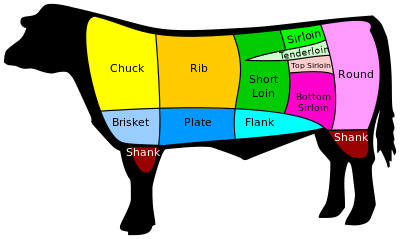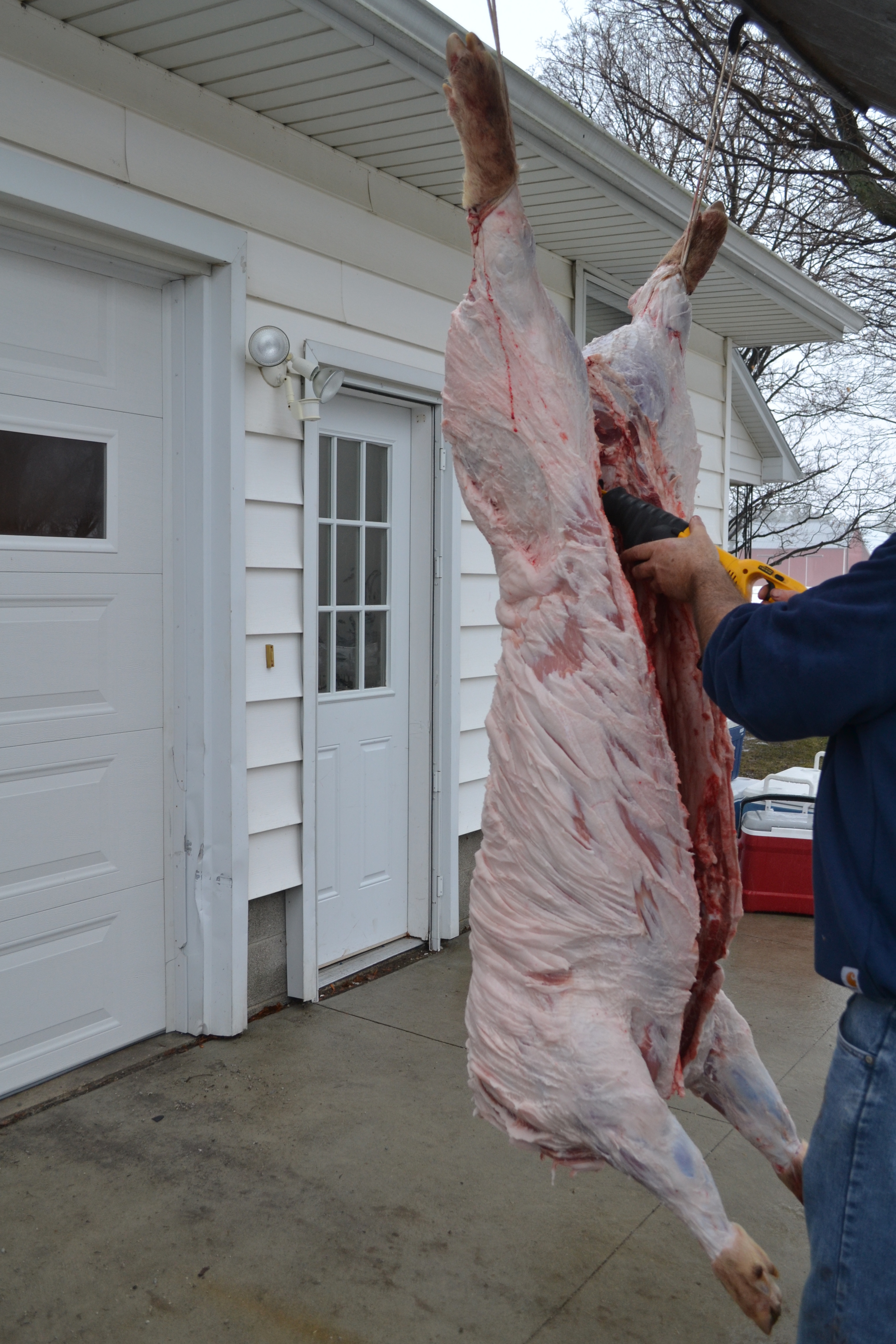
When we are at the grocery store standing in front of the meat counter and wondering what to have for dinner --- all the different cuts of beef displayed confuse us so we just buy a package of ground meat and walk --- run -- away from this meat confusion.
Our intent with this writing is to help remove that confusion. We plan to provide you with enough information that will allow you to walk the total meat case with confidence and purchase what you want and not just settle for "whatever".
THE FIRST IMPRESSION
Take a look around the total meat department. Is it really clean, neat and does not have a lot of clutter? Are the employees neatly dressed with hair covering and wearing plastic gloves? Are you comfortable purchasing meat here? You decide.
WHAT IS QUALITY BEEF
There are several definitions of the word quality. The United Stated Department Of Agriculture (USDA) has helped you by applying standards to beef. These standards are assigned as different grades. The top three grades are the ones you will most likely, and should find at least one of these at your local grocer or meat shop. If there are no signs or labels telling you which one or ones are at your store -- then ask them. The age of the animal and the amount of marbling (intramuscular fat) are the two major factors that determine the grade assigned by the USDA grader. For our discussion today, the top three grades are all close to within the same age group. Marbling is the major difference. The top three grades are;
USDA PRIME -- has the most marbling of all the grades. Most of this grade of beef is served at white table cloth restaurants. This one will cost the most.
USDA CHOICE -- has a little less marbling than USDA Prime. This is the most common beef sold at retail establishments. More than half the beef grades fall into this grade.
USDA SELECT -- Has less marbling than USDA Choice. This beef will not have as much flavor as the other two grades. Of the three grades, this one should be least expensive.
WHAT IS MARBLING
We have a love/hate relationship with this thing called marbling. We love the flavor it adds to the beef but we are not fond of the calories it might add. Marbling is the small flecks of fat within the muscle tissue. This fat imparts flavor and juiciness in our beef and we all crave that flavor. We may like the appearance of an all lean cut with little to no marbling but we really want that juicy flavor that those little flecks of fat impart.
Now that we know a little about the beef grades -- ask you grocer or meat person the grade of beef that they offer for sale. Remember that USDA Prime will cost you more than USDA Choice while USDA Select will normally cost you the least. This cost information is based on normal market pricing. However, your particular store may run specials, so you will have to determine what you want.
YOU DECIDE
Back in the good old days we might go to the local grocer or corner meat shop and tell "butch" behind the counter what we wanted. He would pick out a good beef cut, maybe make a cooking suggestion and we would be on our way home knowing that the dinner we were about to prepare would be great -- cause "butch" had good quality meats and he knew what you wanted.
Today, we are not sure what we want, let alone how to buy it or maybe we are not sure how to cook it. So, what should we look for when making our beef purchase. And -- where is "butch"?
EYE APPEAL IS BUY APPEAL -- FIRST IMPRESSIONS -- WHAT ARE YOU LOOKING FOR?
You will want to look for a cut of beef that is bright red in color. Look for those flecks of fat within that bright red muscle.
Look for that muscle to be moist in appearance. Drying may start on the edges so pay attention to these. Don't buy a drying out piece of meat.
Dark spots or a cut that is dark all over might mean the meat cutting area may have a sanitation issue. On the other hand, some cuts like the sirloin and the filet mignon have a tendency to turn dark faster than other cut and not because of any sanitation issue. Because of the leanness and structure the muscle fibers these two cuts have a tendency to lose their bright red color a lot quicker than other beef cuts. I have seen these cuts lose their "luster" within 6 or 7 hours after cutting. Nothing wrong with these cuts that would make them turn from bright red but just the muscle structure. These would still be considered "fresh cut" but bottom line, be cautious of meat that is not a bright red color and moist in appearance. After all you worked hard for that money you are about to spend.
SO WHAT'S FOR DINNER
We are on our way home from that hard day at work and need to stop at your market for dinner and guess what --- you have no idea what you are going to have. To help you decide you should think about a cooking method. The cooking method is determined by where the cut comes from. Meaning, from what section of the animal did the cut come from?
Let's keep this simple.
Generally speaking, as we look at the diagram of the beef above, the front end (chuck, brisket and shank) and the back end (round and shank) will require a moist heat or require a marinade that will tenderize these muscles. Why? Because this beef animal weighs over 1,000 pound and these front shoulders and hind legs carry this heavy weight around and are almost constantly in motion as the animal walks . It takes a lot of muscle to do this.
The more these muscles work, the thicker the muscle fibers become and the less tender these muscles become. A moist cooking method and/or a marinade helps reduce the thickness of these muscle fibers and thus the meat becomes more tender. Let's continue to keep it simple and know that moist heat and/or marinade work on the end cuts to make them more tender.
Let's list a few of the cuts from these two areas. Looking at the diagram above we see the round as one of those areas that would get a lot of work. From this hind leg (round) we might see in our meat case the following that can be displayed as steaks or as a roast:
Full cut round, top round, bottom round or eye of round
Referring to the list above, we see the front end consists of the chuck and brisket. Some of the cuts we might find displayed in your meat case would be:
chuck steak/roast, shoulder steaks/roasts, brisket roast
I have listed a few of the names of the cuts that you might find in your meat case from these less tender but very flavorful cuts.
Now remember that for the most part these cuts will need moist heat and a little longer to cook than the middle meats such as Rib eyes, strips, t-bones or porterhouse steaks. So, if you are in a hurry, please try to avoid these "end cuts" from the chuck and round. However, remember these are normally less expensive cuts so a little planning on your part will save you some money. And remember these will have some great flavor.
If you need proof of this, a foolproof cooking method would be to purchase a chuck roast and place in your crock pot with some onions, carrots, and potatoes and some broth or water. Let cook until meat is fork tender and enjoy.
Other moist cooking methods would be braising, steaming/stewing, or simmering. All require the use of some form of liquid.
Remember, we are trying to keep this simple.
Not all the end cuts need cooked in a crock pot as some such as the roasts from the round could be cooked in the over but I would recommend cooking at a low temperature (250°F), placed on a rack on a cookie sheet and covered. Put a half a cup of water in the cookie sheet. This low temperature will require more time to cook the roast but will have less tendency to dry out the meat.
Can you remember from science class the temperature that water boils? 212° F is the boiling point of water so I ask you --- why crank the oven up to a high temperature and boil all the moisture out of the meat? So let's keep the temperature low for a moist and tender piece of meat.
Now lets take a few minutes and talk about what is commonly called the middle meats. After all, when you look at the diagram above, we have already talked about two ends of the animal -- the round and the chuck, so the items that are the rib, the short loin, the sirloin and the tenderloin are what are called the middle meats -- between the two ends. They are located on either side of the backbone. These muscles do not get the work that the end muscles do, so they will be more tender.
So our cooking method for these less worked muscles can be a dry heating method. Roasting, broiling, grilling, or even pan frying are considered some dry cooking methods.
When you are standing in front of your meat case, some of the names on the packages from these cuts are;
Rib eye steak or roast, strip steak, tenderloin steak, t-bone steak and porterhouse steak, sirloin steak
The rib eye steak or roast is one that may have a little more marbling and has great flavor. The rib eye muscle is a continuation of the same muscle that is in the chuck.
The strip steak is a continuation of the same muscle as the rib eye. As you look at the diagram above it is located in the short loin section.
The tenderloin is underneath the strip and sirloin sections but has part of the vertebra separating it from the strip/sirloin. Remember, we are going to keep this simple -- so just remember that this tenderloin muscle does very little work and is rated as the most tender muscle in the beef animal. This is reflected in the price.
The T-Bone and Porterhouse come from the short loin. They are made up of the strip and the tenderloin along with the vertebrae bones. This bone is in the shape of a T -- thus T-Bone steak. Told you we would keep it simple. The only difference between a t-bone and a porterhouse is size of the tenderloin. A good rule of thumb is that if the tenderloin is smaller than a golf ball, then it will be a T-Bone. If bigger than a golf ball, then it will be a Porterhouse. Technically it is 1 1/4 in. is the measurement that differentiates the two. But really, the muscles are the same.
Sirloin steaks are as you can see from the diagram located as the hip area. This muscle does a little more work the the other middle meat muscles and may not be as tender as, let's say the rib eye.
Remember that where the piece of meat comes from determines the cooking method.
Remember the names of the end cuts as on the diagram above and plan your cooking method accordingly. Just because the label makes reference to steak.
I hope you will enjoy only the freshest, most flavorful meat after reading this!








